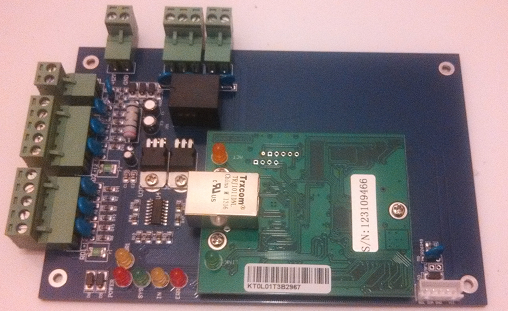This library allows python to control one of the most common RFID Access Control Systems sold in China. Now you can integrate an access control system with your software to do things like remove an user when they have failed to pay their bill.
The goal of this project is to provide the ability to automate an inexpensive, out-of-the-box RFID Access Control solution. This is especially made for businesses that rely on access control + monthly billing (hackerspaces, makerspaces, and gyms).
- Programmatically add and remove users to/from the access control system
- Programmatically trigger the relay to open the door
- Convert the 10-digit format RFID numbers to comma format or vice versa
This library currently only works with a single type of controller which goes by a wide variety of model numbers. The controller can be found by searching for "TCP access control" on Ebay, Aliexpress, and Amazon. It costs around $30-85 (depending on the number of doors). You can know which one to buy by looking for one that looks like this:
One of the awesome things this controller has is a web interface. You can also add users, remove users, view logs, and change settings manually through that interface. Pictures of the interface are available here: http://imgur.com/a/Mw04Y
There are two numbers on the card. The access controller only uses the right number which I'm calling comma-format.
My usage example below shows an example of a function which converts the number on the left (which I'm calling 10-digit format) to the number on the right (comma format).
Install:
pip install Chinese-RFID-Access-Control-Library
Add user (using 10-digit format RFID number):
from rfid import ten_digit_to_comma_format, RFIDClient
ip_address = '192.168.1.20' # IP address of the controller
controller_serial = 123106461 # serial number written on the controller
client = RFIDClient(ip_address, controller_serial)
badge = ten_digit_to_comma_format(11111111) # badge number needs to be converted to "comma format"
client.add_user(badge, [1, 2]) # add privileges for door 1 & 2
Remove user (using 10-digit format RFID number):
from rfid import ten_digit_to_comma_format, RFIDClient
ip_address = '192.168.1.20' # IP address of the controller
controller_serial = 123106461 # serial number written on the controller
client = RFIDClient(ip_address, controller_serial)
badge = ten_digit_to_comma_format(11111111) # badge number needs to be converted to "comma format"
client.remove_user(badge)
Open door #1:
from rfid import RFIDClient
ip_address = '192.168.1.20'
controller_serial = 123106461
client = RFIDClient(ip_address, controller_serial)
client.open_door(1)
- Add an optional name parameter to add_user. The access controller also stores the user's name.
- The controller also stores the user's 2-factor pin for when the keypad is enabled. Need to add an optional parameter to add_user for a pin.
- Add a get_users method to RFIDClient that outputs a list of all the users currently in the controller.
- Add a get_logs method to RFIDClient which outputs the card swipe logs.
- Thanks to Brooks Scharff for figuring out the cool stuff that this access controller could do and keeping me interested in the project.
- Thanks to Dallas Makerspace for letting me implement and test it at their facility.
- Thanks to Mike Metzger for his work on starting to reverse engineer Dallas Makerspace's first access control system and documenting it to show me how to do it. https://dallasmakerspace.org/wiki/ReverseEngineeringRFIDReader

